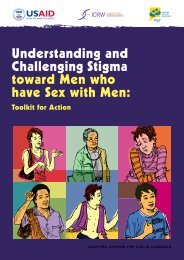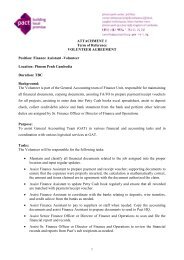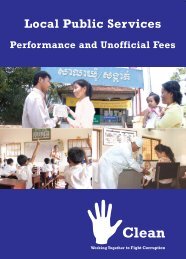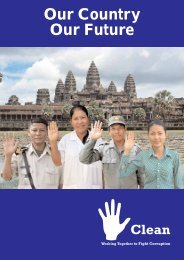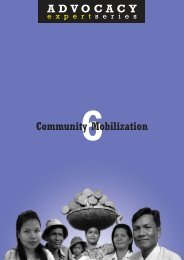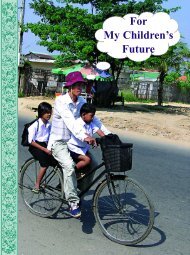Advocacy in Cambodia: Increasing Democratic ... - Pact Cambodia
Advocacy in Cambodia: Increasing Democratic ... - Pact Cambodia
Advocacy in Cambodia: Increasing Democratic ... - Pact Cambodia
Create successful ePaper yourself
Turn your PDF publications into a flip-book with our unique Google optimized e-Paper software.
Case Studies<br />
parents or concerned citizens, four local<br />
authorities, and six to eight representatives from<br />
NGOs and prov<strong>in</strong>cial departments. The network<br />
is designed to provide a mechanism for parents<br />
and children to identify problems and relay<br />
<strong>in</strong>formation to local and prov<strong>in</strong>cial authorities,<br />
while giv<strong>in</strong>g authorities a mandate to respond to<br />
problems.<br />
When the orig<strong>in</strong>al prov<strong>in</strong>cial networks were<br />
formed, participants were selected from too wide<br />
an area and as a result had divergent concerns as<br />
well as logistical difficulties <strong>in</strong> meet<strong>in</strong>g. LICADHO<br />
has s<strong>in</strong>ce altered its strategy to target communes<br />
and districts that identify child labor as a problem<br />
and the model has become more effective. Project<br />
staff is cont<strong>in</strong>uously look<strong>in</strong>g for ways to improve<br />
the model, and elements of success <strong>in</strong>clude the<br />
commitment of network members, the strength<br />
of the network chairperson, and the wide<br />
geographic distribution of members.<br />
LICADHO bases its work on the theory that<br />
even before an NGO enters a community there are<br />
community leaders who are concerned about a<br />
problem and who perhaps try to act on their<br />
concern. LICADHO’s strategy is to f<strong>in</strong>d exist<strong>in</strong>g<br />
social networks and build their capacity.<br />
LICADHO’s program has also designed effective<br />
media strategies to communicate their messages<br />
to community members. These strategies <strong>in</strong>clude<br />
photos and simple visual signs about the worst<br />
forms of child labor.<br />
Analyz<strong>in</strong>g The Impact Of <strong>Advocacy</strong><br />
Activities<br />
<strong>Advocacy</strong> activities related to child’s rights<br />
<strong>in</strong> <strong>Cambodia</strong> consist ma<strong>in</strong>ly of awareness rais<strong>in</strong>g,<br />
mobiliz<strong>in</strong>g people to apply the terms of the UN<br />
Convention, and produc<strong>in</strong>g International<br />
Education and Communication (IEC) materials<br />
such as child abuse posters. Advocates are<br />
regularly challenged by the difficulty of gett<strong>in</strong>g<br />
policy makers to make child’s rights a priority.<br />
Child’s rights advocacy <strong>in</strong> <strong>Cambodia</strong> appears to<br />
lack a champion of the caliber of some child rights<br />
activists <strong>in</strong> Thailand like Meechai, who draws<br />
attention to the issue.<br />
Policy<br />
<strong>Cambodia</strong>’s ratification of the UN<br />
Convention on the Rights of Children represents<br />
a first step <strong>in</strong> br<strong>in</strong>g<strong>in</strong>g the protection of children<br />
to the forefront of the government’s agenda. This<br />
has been followed by the creation of the CNCC.<br />
However, the government’s reports to the UN<br />
(such as the one submitted <strong>in</strong> 1999) cont<strong>in</strong>ue to<br />
downplay the real situation of children <strong>in</strong><br />
<strong>Cambodia</strong> and the perception of NGOs is that the<br />
CNCC cont<strong>in</strong>ues to be weak. The M<strong>in</strong>istry of Social<br />
LICADHO’s efforts to raise community concern are<br />
beg<strong>in</strong>n<strong>in</strong>g to result <strong>in</strong> community action. The Siem<br />
Reap prov<strong>in</strong>cial child’s rights committee was recently<br />
notified of a case of a child who had been <strong>in</strong> bonded<br />
labor for years. People familiar with the situation felt<br />
that the child should have paid off the debt years<br />
prior. The network decided to act on behalf of the<br />
child and asked the employer <strong>in</strong> question to show<br />
some sort of account<strong>in</strong>g of the child’s debt. In another<br />
case, a child was separated from his parents and<br />
forbidden by his employer to visit his family’s home.<br />
Committee members approached the employer to<br />
make the case that it is wrong to take away a child’s<br />
freedom. As a result, the employer now allows the<br />
child to make occasional home visits.<br />
Affairs’ Sub-committee on Child Labor that meets<br />
every two months has proven more effective <strong>in</strong><br />
promot<strong>in</strong>g children’s rights. Currently much of the<br />
government’s <strong>in</strong>terest regard<strong>in</strong>g child rights is<br />
propelled by UN agencies, though this comes as<br />
little surprise given the myriad basic needs issues<br />
on the government’s agenda.<br />
With regard to legislation, the government<br />
has issued a proclamation (prakas) on the<br />
protection of children, though NGOs had no <strong>in</strong>put<br />
<strong>in</strong>to this document. Sub-decrees are currently<br />
be<strong>in</strong>g prepared regard<strong>in</strong>g birth registration and<br />
adoption. Aga<strong>in</strong>, NGOs are not <strong>in</strong>volved, though<br />
they would like to be. A chapter of the new penal<br />
code, which is currently be<strong>in</strong>g revised, relates to<br />
children and NGOs have sent recommendations<br />
to the M<strong>in</strong>istry of Justice on it.<br />
While NGOs have met with members of the<br />
National Assembly, they do not have full access<br />
to Parliament and high government officials. As a<br />
result, lobby<strong>in</strong>g on legislation related to child’s<br />
rights has been weak. This is a problem<br />
encountered <strong>in</strong> other sectors where advocates are<br />
young professionals who have not had time to<br />
build sufficient legitimacy to conduct successful,<br />
high-level lobby<strong>in</strong>g. Another challenge<br />
encountered by NGOs is a lack of legal expertise<br />
to analyze legal articles.<br />
Enlarg<strong>in</strong>g the <strong>Democratic</strong> Space<br />
As alluded to above, the <strong>in</strong>clusion of civil<br />
society organizations <strong>in</strong> child’s rights policy<br />
formulation is not systematic. While government<br />
officials attend International Children’s Day<br />
celebrations and other awareness rais<strong>in</strong>g events,<br />
they currently do not seek out NGOs to provide<br />
<strong>in</strong>put <strong>in</strong>to legislation and policies affect<strong>in</strong>g<br />
children. Unlike many of the other sectors, the<br />
child’s rights movement does not benefit from<br />
particular donor <strong>in</strong>terest that would help to raise<br />
94




